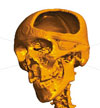|
by Lay Leng TAN

 eople suffering head injuries who need surgical repair to their damaged skulls are usually given bone harvested from another part of the body or a titanium plate. finding replacement bone often proves difficult; a titanium implant, although more readily available, carries some risk of infection and can cost more than s$1,000. eople suffering head injuries who need surgical repair to their damaged skulls are usually given bone harvested from another part of the body or a titanium plate. finding replacement bone often proves difficult; a titanium implant, although more readily available, carries some risk of infection and can cost more than s$1,000.
A group of engineers and doctors from the national university of singapore and national university hospital, in collaboration with temasek polytechnic, has developed material made of biodegradable plastic to address this problem. the biocompatible polycaprolactone (pcl) polymer provides a base for the bone of the skull to regenerate and cover over a hole, says swee-hin teoh, one of the principal team members from the nus department of mechanical engineering. a soft- and hard-tissue-compatible bioresorbable material, pcl has been approved by the us food and drug administration for a number of medical and drug-delivery devices.
by constructing a three-dimensional (3d) architecture with interconnected pores, the scientists produce a scaffold that makes possible good cell entrapment, easy flow of nutrients and waste removal, and long-term cell life. teoh explains that his team creates 3d patient-specific scaffolds, utilising the fused deposition modelling (fdm) rapid prototyping advanced manufacturing process. the platform technology to tissue engineer the scaffold - which combines medical imaging, computational mechanics, biomaterials, and advanced manufacturing - allows direct image transfer to produce an exact shape without a mould. this not only saves cost but also reduces pathogen transfer and ensures a minimum of infection.
the scaffold can be fabricated to fit the patient's defect and be cut to size rapidly and accurately. it can also be fashioned easily for minor shape adjustment in the surgery room by the use of warm water since the pcl is a thermoplastic with a softening temperature just below 60oc. the slow degradation and assimilation of the polymer over 24 months allows good bone healing, provides adequate mechanical support, and maintains the shape of the skull without problems.
a 23-year-old patient who met with an industrial accident two years ago was admitted to nuh as one of the first test subjects to receive the new fdm scaffold. the engineers fashioned a 3d pcl scaffold that followed the curvature of the patient's skull; then they injected some of his living bone cells into the interconnected architecture of the scaffold. more than two years have passed and the patient is doing well, giving clinical confidence for the long-term usage of the fdm scaffold. his hair grew back and the scaffold fused smoothly with the surrounding tissue.
for a patient who sustains a head injury related to an accident or a stroke, surgeons usually perform a burr-hole procedure that involves drilling a hole 19mm in diameter into the skull. the hole is then closed after surgery with titanium mesh. the team took an alternative approach using its platform technology to design a burr plug shaped like a flattened button mushroom to fill the hole and create a 3d environment for cell attachment, growth, and differentiation. after a clinical follow-up of three months, more than 14 patients who had been fitted with the implants showed good integration of plugs into the skull bone, without swelling or even signs of the holes. for the first time new bone grew back to fill the hole which would otherwise have remained as a permanent depression.
encouraged by the success, the group set up a company called osteopore international to market the new material. available in asia now, the burr plug is being sold at a price of about s$600, almost half that of a high-end titanium plate, says dietmar hutmacher, who is with the nus bioengineering division. he expects the material to be used on the aged and people with head trauma, but a number of different products in the areas of orthopaedic and dental surgery are also in the pipeline.
the global market for the new material could have a value of us$150 million, he estimates. enquiries are already coming in from countries in asia, europe, south america, and japan. some international venture capitalists and investors have indicated a keen interest in having a stake in osteopore's expansion. the company now has a full team of professionals with more than 20 years' experience in manufacturing and marketing medical devices. teoh emphasises that the key strength at osteopore, apart from the r&d and technology, is in the experience of the team in understanding the business development, marketing, regulatory issues, and manufacturing of medical devices - something which is presently lacking in singapore.
the researchers have filed two patents for the work. for the future, they are next exploring using the scaffold to grow bone around the eye socket and in the spine, as well as cartilage on knees.
for more information contact swee-hin teoh at mpetsh@nus.edu.sg or check out www.osteoporeinternational.com
 click here to download the full issue for usd 6.50 click here to download the full issue for usd 6.50
|



 eople suffering head injuries who need surgical repair to their damaged skulls are usually given bone harvested from another part of the body or a titanium plate. finding replacement bone often proves difficult; a titanium implant, although more readily available, carries some risk of infection and can cost more than s$1,000.
eople suffering head injuries who need surgical repair to their damaged skulls are usually given bone harvested from another part of the body or a titanium plate. finding replacement bone often proves difficult; a titanium implant, although more readily available, carries some risk of infection and can cost more than s$1,000.
 click here to download the full issue for usd 6.50
click here to download the full issue for usd 6.50